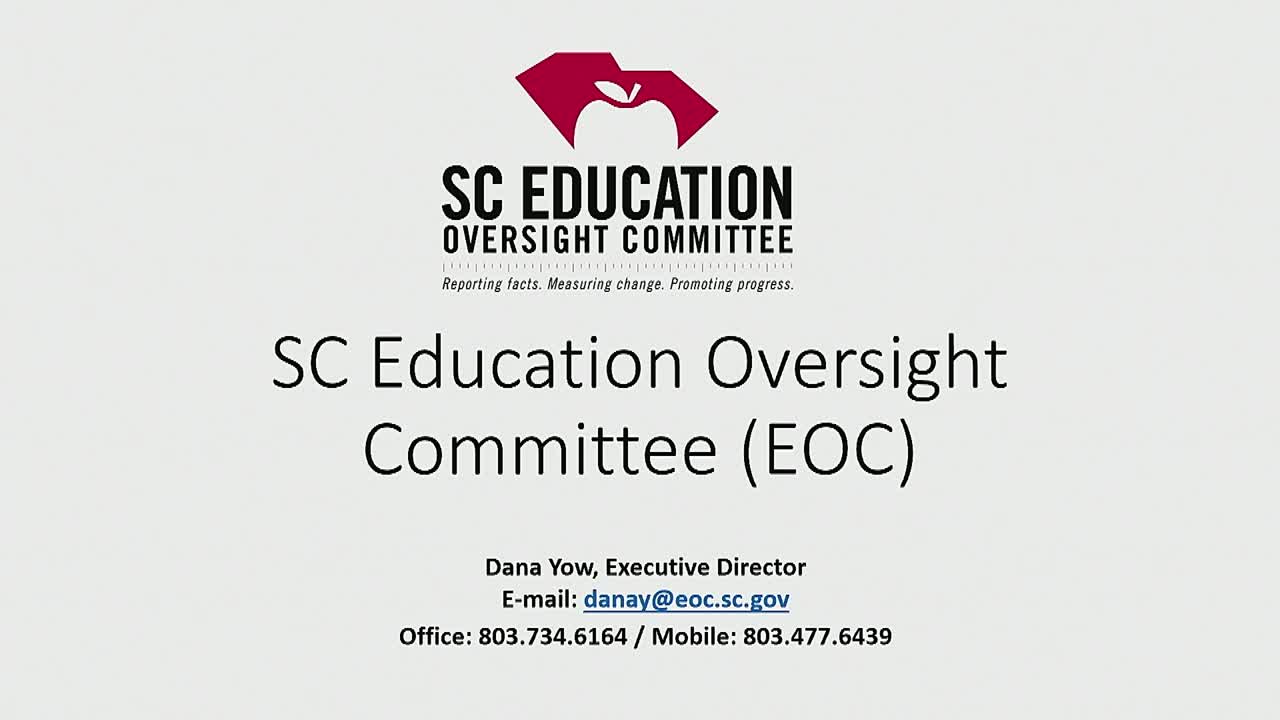Education Oversight Committee: 85.4% on‑time graduation; members press on readiness, absenteeism and rural teacher recruitment
May 01, 2025 | 2025 Legislative Meetings, South Carolina
This article was created by AI summarizing key points discussed. AI makes mistakes, so for full details and context, please refer to the video of the full meeting. Please report any errors so we can fix them. Report an error »

Dana Yao, executive director of the Education Oversight Committee, told the House Education and Public Works Committee on Oct. 12 that the committee’s 2024 on‑time graduation rate for public high school students is 85.4 percent and that the EOC produces annual accountability reports and program evaluations used by the General Assembly.
The presentation described the EOC’s statutory duties: approving K–12 content standards and statewide assessments used for accountability, producing the public school report cards issued annually by Oct. 15 and evaluating state‑funded programs including full‑day 4K, the Educational Credit for Exceptional Needs program, teacher loan programs and services for military‑connected students. “We do an annual evaluation of that,” Yao said of the full‑day 4Ks, adding, “the studies that we have done…show that that program does work for 4 year olds.”
Why it matters: Committee members focused on a persistent gap between students who graduate on time and those who leave high school with a recognized credential or the test scores typically used to show college readiness. Yao showed charts on college‑ and career‑readiness alongside the graduation rate; during questions members referenced different readiness figures that appeared in the presentation.
Committee discussion emphasized absenteeism and teacher recruitment. Yao flagged chronic absenteeism as “a big factor” and described the EOC’s dashboard (dashboardsc.sc.gov) and recent focus groups with students and parents to investigate causes. The EOC is also evaluating a rural recruitment initiative funded with EIA (Education Improvement Act) money; Yao said the state is investing $7,600,000 of EIA funds in rural recruitment incentives that districts may use for mentoring, housing, recruitment fairs and other incentives and that the EOC assessed those incentives’ return on investment.
Members pressed for additional detail and follow up. Representative Bridal asked, “So what in the hell are we doing wrong in South Carolina?” after Yao confirmed the 85.4 percent graduation figure and discussed the share of graduates meeting college‑and‑career readiness measures. Yao and committee members said the EOC would provide slides and additional requested breakdowns (for example, teacher turnover rates in rural districts and the parent focus‑group results), and invited members to request specific data or meet individually with staff.
Additional details Yao gave to the committee: the EOC operates with a small staff (she identified eight full‑time equivalent positions), produces an education data dashboard that allows drilldowns to individual high schools, and conducts special studies at the legislature’s request (recent work included an evaluation of rural recruitment incentives and alternative modes of instruction).
What’s next: Yao said the EOC plans further study of rural recruitment incentives and absenteeism and will share the committee’s requested materials. Committee members asked staff to follow up on the EOC’s analyses and to circulate the slides shown during the briefing.
The presentation described the EOC’s statutory duties: approving K–12 content standards and statewide assessments used for accountability, producing the public school report cards issued annually by Oct. 15 and evaluating state‑funded programs including full‑day 4K, the Educational Credit for Exceptional Needs program, teacher loan programs and services for military‑connected students. “We do an annual evaluation of that,” Yao said of the full‑day 4Ks, adding, “the studies that we have done…show that that program does work for 4 year olds.”
Why it matters: Committee members focused on a persistent gap between students who graduate on time and those who leave high school with a recognized credential or the test scores typically used to show college readiness. Yao showed charts on college‑ and career‑readiness alongside the graduation rate; during questions members referenced different readiness figures that appeared in the presentation.
Committee discussion emphasized absenteeism and teacher recruitment. Yao flagged chronic absenteeism as “a big factor” and described the EOC’s dashboard (dashboardsc.sc.gov) and recent focus groups with students and parents to investigate causes. The EOC is also evaluating a rural recruitment initiative funded with EIA (Education Improvement Act) money; Yao said the state is investing $7,600,000 of EIA funds in rural recruitment incentives that districts may use for mentoring, housing, recruitment fairs and other incentives and that the EOC assessed those incentives’ return on investment.
Members pressed for additional detail and follow up. Representative Bridal asked, “So what in the hell are we doing wrong in South Carolina?” after Yao confirmed the 85.4 percent graduation figure and discussed the share of graduates meeting college‑and‑career readiness measures. Yao and committee members said the EOC would provide slides and additional requested breakdowns (for example, teacher turnover rates in rural districts and the parent focus‑group results), and invited members to request specific data or meet individually with staff.
Additional details Yao gave to the committee: the EOC operates with a small staff (she identified eight full‑time equivalent positions), produces an education data dashboard that allows drilldowns to individual high schools, and conducts special studies at the legislature’s request (recent work included an evaluation of rural recruitment incentives and alternative modes of instruction).
What’s next: Yao said the EOC plans further study of rural recruitment incentives and absenteeism and will share the committee’s requested materials. Committee members asked staff to follow up on the EOC’s analyses and to circulate the slides shown during the briefing.
View full meeting
This article is based on a recent meeting—watch the full video and explore the complete transcript for deeper insights into the discussion.
View full meeting